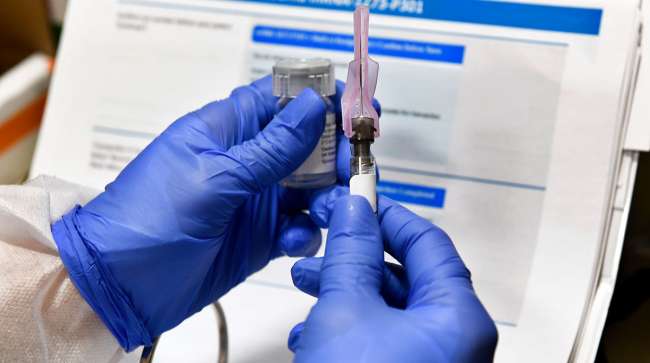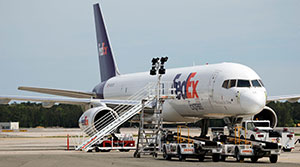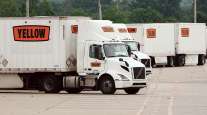Senior Reporter
Logistics Community Optimistic About Distribution of COVID-19 Vaccines

[Ensure you have all the info you need in these unprecedented times. Subscribe now.]
With optimism building that two COVID-19 vaccines could be available by year’s end, supply chain experts are outlining steps and discussing challenges that lie ahead for those in charge of transporting the anxiously awaited medicine.
“This will be a pretty tough thing to do — it’s a huge challenge,” Dale Rogers, a supply chain management professor at Arizona State University, told Transport Topics, pointing specifically to maintaining temperatures cold enough to transport the doses. The vaccine from pharmaceutical firm Pfizer must be transported at temperatures near minus 94 degrees Fahrenheit — 20 degrees colder than winter at the South Pole — to remain effective.
“You can’t invent subzero capacity that easily,” Rogers said. “Even just getting employees who can operate in a minus 100 environment — people can’t stay in there very long, the machines don’t work that well.”
The vaccine being developed by medical research firm Moderna must be shipped at comparatively less frigid minus 4 degrees Fahrenheit, but can be kept in a standard refrigerator for up to 30 days. Pfizer’s vaccine may only remain effective in a freezer for five days.
To transport its vaccine, Pfizer designed a deep-freeze container that can be sealed and then shipped — even in non-refrigerated trucks — for up to 10 days with dry ice inside.
Pfizer said its vaccine is 95% effective; Moderna said its variant is 94.5% effective. Both vaccines require two shots, administered weeks apart.
Beyond spacing out the shots, Rogers is concerned about ensuring appropriate supplies of the vaccines reach doctors.
“I think it’s going to be a lot easier in some places than others,” he said, noting that some of the trucking industry’s larger players are already working on the logistics of shipping the vaccine.
“I think the carriers, FedEx, UPS and others have spent a lot of time thinking about this,” Rogers said. “I’m not that worried about the transportation of the vaccine. I think they’re ready for it and have built the freezer capacity they’ll need.”
In a statement, UPS said its response to the pandemic had provided added visibility into how to safely move critical medical supplies.
“UPS teams around the world are working hard to deliver increased package volume as a result of the pandemic,” the company said. “Additionally, we have visibility into the needs and demands regarding vaccines and testing and are preparing our network to help deliver in support of urgent, lifesaving operations.”
Previously, both FedEx and DHL had expressed confidence they would have or will build the additional shipping and refrigeration capacity to ship the vaccine.
Robert Trent, a supply chain management professor at Lehigh University, told TT he believes the distribution will go smoother if the number of companies that deliver the vaccine is limited.
The pharmaceutical companies are going to have to work very closely with a couple of third-party logistics companies and let them run it, control it from a security and safety perspective,” Trent said. “This might be one of the first times you also implement blockchain technology too, all the way to the end-user, or the end doctor.”

(Steve Helber/AP)
READ MORE
Blockchains are an open, distributed ledger that can record transactions between two parties efficiently and in a verifiable and permanent way. Trent says utilizing blockchain is one way pharmaceutical companies and 3PLs can verify where a vial of the vaccine has been, under what conditions, and who had access to it.
Christina Scherrer, an industrial engineering professor at Kennesaw State University in Marietta, Ga., told TT blockchain technology is a good option because it gives the transportation providers more information.
“You have to keep the product cold and monitor the temperature to make sure that it’s staying cold,” she said. “You don’t want the vaccine to get damaged by getting it too warm during the transportation.”
Potential shipments during the height of the holiday season also present challenges, noted Penn State logistics professor Peter Swan. He’s worried that the combination of virus shipments and e-commerce deliveries will tighten capacity in an industry already stretched thin.
“Part of the cost of distributing vaccine may be the delay of other domestic shipments,” he said. “Estimates for airfreight requirements for vaccine distribution suggest that it may crowd out capacity for all other shipments. ‘Shipageddon’ has already been forecast for the holiday season before vaccine distribution was considered. Now both airfreight and ground distribution are likely to be overwhelmed by both domestic shipments and vaccine distribution. Vaccine distribution will get priority, which means that holiday gifts may come late this year.”
Want more news? Listen to today's daily briefing:
Subscribe: Apple Podcasts | Spotify | Amazon Alexa | Google Assistant | More




